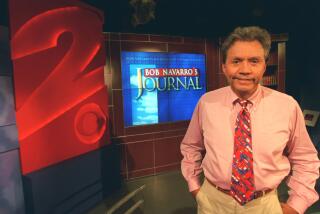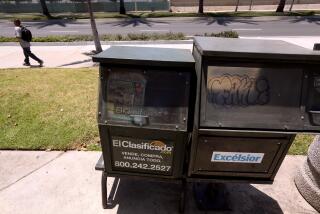Column: No more Mr. News Guy -- L.A. anchor Kent Shocknek signs off

Kent Shocknek, who spent 31 years in the TV anchor chair in LA retires after a lifetime of car chases, fires, space shuttle stories and quakes, like the 1987 aftershock that famously saw him do the right thing: duck under his desk.
- Share via
Notice something missing from your TV news this week? It’s Kent Shocknek, who spoke to The Times two days before signing off Friday, after 31 years in the anchor chair on two stations, KNBC and KCBS/KCAL. He so fits the role, he got anchor cameos in the movies. His tenure, one of the longest of any L.A. anchor, spanned immense changes in the news, from a local early-morning show he pioneered to the age of online video. Although viewers will miss him, here’s something the man himself won’t miss: his watch alarm sounding 11 times a day to summon him to a broadcast.
What’s the argument for TV news — appointment news — when there’s the Internet?
TV news has skilled people who can judge what’s important, what’s new, what’s interesting, put it in context and present it in a way that’s of value to the viewer. I believe that to the very fiber of my being. In the, quote, old days, more people were home, sitting down in front of the 26-inch black-and-white Magnavox watching the 6 o’clock news. Now we time-shift the biggest stories. At 6 o’clock we know about the event, at 8 o’clock we have reaction, and at 10 o’clock we have outcome.
How else has technology influenced TV news?
A viewer can say, “I saw this story on CBS,” maybe on a television station, an online video, a tweet — but because it carries the CBS brand, it carries credibility. I think our news division is not concerned about the proliferation of platforms — quite the opposite. We’re excited by the opportunity to spread the word even further.
In the mid-1970s, you went to USC for print journalism but the classes were full, so you switched to broadcast. How has public regard for reporting changed since then?
The definition of journalism has changed, or people’s perception of the definition. Now, on the “CBS Evening News,” I can watch a half-hour of world and national events or I can go down the dial to some Hollywood gossip show that does not fit my definition of news, but may fit someone else’s. Well, why not? It’s on at the same time, the anchor is also sitting at a desk, they’re also showing video clips, [but] they’re talking about a celebrity instead of a leader of state. Smart audiences — and news audiences are smart — can see where the pursuit of truth is not quite as aggressive.
Has the proliferation of entertainment shows affected the appetite for real news? Are the two conflated when the news leads with Justin Bieber egging a house rather than a City Hall story?
We do have someone at City Hall. We make sure viewers’ plate is full — with everything that’s nutritious, the newest, the most interesting, what affects us the most, and if there’s room on the plate, a little dessert’s not going to kill you. This is an industry town. In Detroit they make cars, so they talk about cars on the news. Here we make entertainment, so we talk about entertainment.
I don’t think even major L.A. TV stations have Sacramento bureaus anymore. Don’t changes like that affect news coverage?
Technology has made it simpler to collect the news. There was a time when full-time reporters in Sacramento were sending canisters of film in a shoe box on a Greyhound bus to the station to air the next day. Now we can make a telephone call to our Sacramento affiliate. Technology has made it easier to get the same information. It’s simple to say to the politician, “Will you sit down in your Assembly studio for a satellite interview with our political reporter, Dave Bryan?” The opportunities are the same.
Video used to be shot by a guy with a huge camera on his shoulder. Now anyone can use a smartphone. How has that affected coverage?
It’s really the 21st-century version of an anonymous tip. The person who gave that tip may not have had the ability to tell the whole story but certainly can get the ball rolling.
Do you write the copy you read?
I generate almost zero percent of my own copy, but by the time I read something on the air, I’ve probably changed about 50% of it, only because the writer may have moved on to something else while I have a chance to look for updates. I call it tinkering. The writers probably call it — what’s the word?
“Screwing with my copy”?
Sticking my nose in! I tell the writers their copy is the best in the world, but I’m the one who reads it, so I may put in a comment here or there.
You interview people, so you get carte blanche to be sometimes, well, intrusive.
I’m aware that I’m intrusive, and sometimes I’m not comfortable with that. If someone is in anguish, I don’t want to intrude. Perhaps that’s why I’ve been more successful in the studio than out in the field. I have endless admiration for our reporters who have the compassion to be able to walk up to the door of a family that’s just suffered a loss and get those family members to open up. I wouldn’t have the guts.
Where was your first TV news job?
Sioux City, Iowa.
Your first story there was … ?
How were farmers dealing with the shortage of baling wire. I was only in Iowa for a year and a half; it was just too cold. I was hired in Orlando as a bureau reporter at the Kennedy Space Center. I was there just in time for the final run-up to the first space shuttle launch. I earned $12,000 a year. Couldn’t have been happier.
You were on the air Oct. 1, 1987, when the Whittier quake hit. The Red Cross honored you with a safety award for doing the correct thing — getting under your desk during an aftershock. Some people still give you grief about that.
I’m a California boy who went through the drills in grade school. I was in a studio with an 80-pound light swinging over my head. My job was to communicate what was going on, so I thought I needed to stay at my post.
[Reporting] in El Salvador in the early 1980s, we were in a field in which a firefight broke out. Everyone got down quickly; I didn’t want to get my clothes dirty so I was standing there. The woman I was with, a local, said, “Get down.” I said, “They’re not shooting at us, I don’t think.” She said, “If you want to wait to see if this bullet is coming toward you, then keep standing up.”
When the earth starts to shake, we don’t know if this is going to be a microquake or something major. I learned from El Salvador, don’t wait to see if the bullet is coming at you. Act now.
Any stories you wish you’d had a chance to do?
No, I’ve been at this buffet table for so long I think I’ve sampled everything. I like seeing the same topic come up a second or third or 10th time and trying to discern the shadings that make it new and newsworthy. The space shuttle Endeavour was an exciting example. Because of my roots, getting to go full circle from the rollout of the very first one to the final drive of the last one in L.A. was a pretty nice parallel track to my career.
How will you watch the news, once you’re no longer on it?
I am a creature of habit. I hope to get up, turn on the news, see what I missed overnight, see what’s coming up, see whether I need to wear a sweater and whether I’ll be able to take the 405. Beyond that I’ll probably be talking back at the TV set.
I was listening to the radio on the drive to work today. The stories were another hurdle for California’s high-speed rail, the influence of immigrant voters, and the pig races at the L.A. County Fair. Those are three stories I heard on the radio on the way to work the day I started in L.A. in September 1983. I wrote them down: bullet train, immigrant voters and the pig races at the county fair.
This interview has been condensed and edited.
Twitter: @pattmlatimes
More to Read
A cure for the common opinion
Get thought-provoking perspectives with our weekly newsletter.
You may occasionally receive promotional content from the Los Angeles Times.











